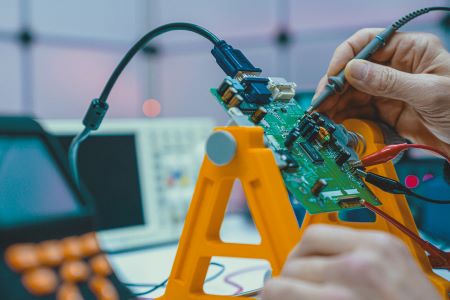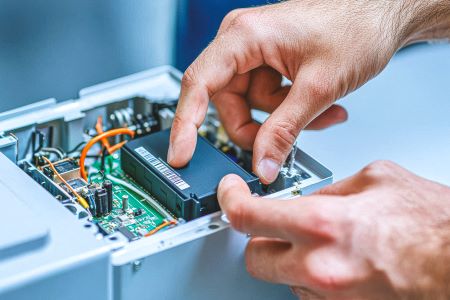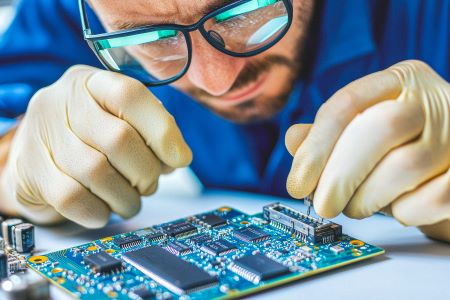In today's rapidly evolving technology landscape, connected devices are no longer just about data collection and remote control. The integration of artificial intelligence and machine learning has given rise to a new breed of products: intelligent connected devices.
These smart systems can analyse data, make decisions, and even learn from their environments offering unprecedented value to users and businesses alike.
For example, here at 42 Technology (42T) we’re developing a portable, battery-powered medical imaging device with built-in intelligence for disease screening. Using data from an earlier version of the device we created, this latest version will help improve diagnoses and reduce misdiagnoses.
It’s been designed for fast, local operation making it suitable for use in rural areas in developing countries. In addition, we are now exploring connectivity options to enable image uploads for record keeping, firmware updates for performance improvements, and in-market monitoring to comply with medical devices regulation (MDR) requirements.
However, creating an intelligent connected product is like preparing a gourmet meal – it requires careful selection of ingredients, precise techniques, and a dash of creativity. So what are the explore key "courses" that make up this sophisticated IoT feast?

The Data Course
Data is the fuel that powers intelligent systems. Determining what data is required, such as sensor readings, user interactions or environmental factors, is critical to providing the necessary intelligence. The data must be accurate, relevant, and diverse enough to train robust models. A further consideration is the implementation of strong data protection measures to comply with regulations like GDPR and to build user trust.
The Algorithm Course
Choosing the right machine learning algorithm is crucial. It’s necessary to clearly define what you want your product to achieve. Is it classification, regression, anomaly detection, or something else?
In selecting the algorithm consider options like neural networks, decision trees, or support vector machines based on your problem and data. In the imaging device example above, the objective is to classify images. Therefore, algorithms that find the best boundary between different classes of data are likely to be most effective, particularly if there is a clear margin of separation in your data.
A further consideration is the transparency of the results. It must be scrutable. Neural networks may not be able to provide the level of interpretation of the resulting output required for some applications, especially those in the medical diagnosis field.
For devices with limited processing power and energy constraints some algorithms are more computationally efficient than others. If a neural network is necessary there are lightweight architectures designed for mobile and embedded devices, such as MobileNet or SqueezeNet. For any chosen algorithm, we’d recommend looking into quantization, weight sharing, and pruning/sparsity techniques to help reduce model size and improve inference speed with minimal accuracy loss.
The best algorithm often depends on your specific use case and constraints. It's worthwhile experimenting with different approaches and measuring their performance on your target hardware. There’s always a balance to be struck between model sophistication with the constraints of your target hardware. For resource-constrained devices, simpler models that perform adequately are often preferable to complex models that strain the system's capabilities.
The Training Course
Training your intelligent device is where the magic happens. The series of steps for training are:
· Data Preparation: Clean and preprocess your data, handling missing values and outliers.
· Model Training: Use techniques like cross-validation to evaluate and test your machine learning model to ensure it generalises well.
· Parameter Tuning: Optimise your model's performance through careful parameter adjustment.
· Evaluation: Rigorously test your model's performance using appropriate metrics.

The Hardware Course
Selecting the right hardware is crucial for ensuring the inference engine runs efficiently. This is the logical element of the system analysing the incoming data and applying rules. When choosing a processor capable of running your inference engine there are options ranging from high-end CPUs to specialised AI accelerators like Google's Edge TPU or NVIDIA's Jetson series.
Hardware considerations include memory size, security, power efficiency, and form factor. Models and data require sufficient memory, and power consumption is crucial for battery-powered or constrained devices. Performance needs must also be balanced with size constraints.
While intelligent connected devices offer advantages, edge positioning increases vulnerabilities, so your device will require stronger security. Edge devices face new attack vectors, such as side-channel attacks, data poisoning during training, and evasion attacks during inference. As reliance on these devices grows, security practices must evolve to counter threats. Measures may include enhanced physical security, improved monitoring, and validation to detect attempts to manipulate device behaviour.
The Connectivity Course
The connectivity requirements for products are shaped by cost, power consumption, range, data rate, and latency, all governed by the laws of physics and economics. Current technologies occupy specific sweet spots within this complex balance.
Most systems need wireless connectivity for Internet access, which is often less reliable and costlier than wired connections. Wireless standards usually involve two device classes: cellular and WiFi. Gateway ownership, reliability and ease of access to the gateway versus mobile networks must also be considered in the selection. Using established standards with broad market acceptance is generally more effective than creating custom solutions.

The Integration Course
Bringing together hardware, software, and AI into a cohesive product requires a range of other design considerations such as software architecture, user experience, continuous learning and regulatory compliance:
• The software architecture must be sufficiently flexible to handle updates to your AI model.
• Creating intuitive interfaces that leverage your product's intelligence while remaining user-friendly can be challenging for many complex products.
• Intelligent connected products offer the advantage of continuous learning, often for free or at minimal cost compared to the value that can be gained. The system should be implemented to collect feedback so the model can be improved over time.
• All products need to adhere to relevant standards and regulations, especially concerning AI ethics and data usage.
So, finally, here’s our recipe for success:
Start with clear objectives: Define what intelligence means for your product and how it adds value.
Invest in high quality data: The cornerstone of any intelligent system.
Choose the right tools: Select hardware and software platforms that balance performance, cost, and development speed. Consider integrated solutions that offer AI capabilities out of the box.
Iterate and refine: Use agile development practices to continuously improve your product's intelligence.
Plan for scalability: Design your system to handle growing data volumes and evolving AI models.
Prioritise security and privacy: Build trust by making data protection a core feature, not an afterthought.
Foster collaboration: Bring together expertise in hardware, software, data science, and domain knowledge.
Optimise for your hardware: When developing for devices with limited resources, prioritise algorithm efficiency alongside accuracy.
In conclusion
Creating an intelligent connected product is a complex but rewarding endeavour. By carefully considering each "course" in this process, understanding the underlying concepts, and optimising for your specific hardware constraints, you can create a product that not only connects to the world but understands and adapts to it efficiently.
Remember, the key to success lies in balancing technological sophistication with practical constraints and user needs. With the right recipe, a solid understanding of machine learning principles, and careful consideration of hardware limitations, your intelligent connected product can stand out in today's fiercely competitive landscape.
- 42 Technology (42T) is a product design and innovation consultancy, based near Cambridge (UK), that helps create technically advanced new products and enhanced manufacturing processes for some of the world’s best-known brands, as well as start-ups and SMEs. It works across three key sectors: consumer, industrial, and healthcare and life sciences.
Author details: Paul Bearpark is head of electronics and software at 42 Technology (42T) and Jack Williamson is an electronics engineer.













